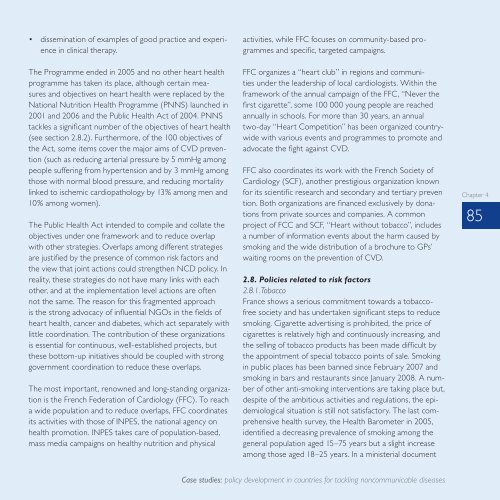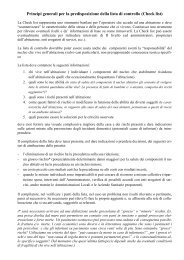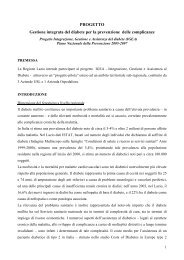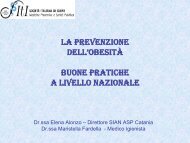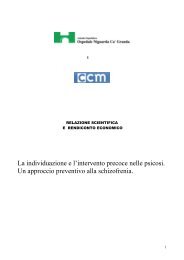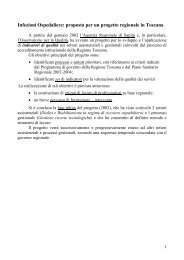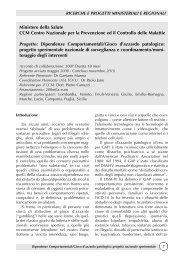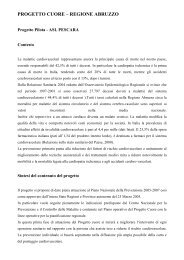Gaining health : analysis of policy development in European ...
Gaining health : analysis of policy development in European ...
Gaining health : analysis of policy development in European ...
Create successful ePaper yourself
Turn your PDF publications into a flip-book with our unique Google optimized e-Paper software.
• dissem<strong>in</strong>ation <strong>of</strong> examples <strong>of</strong> good practice and experience<br />
<strong>in</strong> cl<strong>in</strong>ical therapy.<br />
The Programme ended <strong>in</strong> 2005 and no other heart <strong>health</strong><br />
programme has taken its place, although certa<strong>in</strong> measures<br />
and objectives on heart <strong>health</strong> were replaced by the<br />
National Nutrition Health Programme (PNNS) launched <strong>in</strong><br />
2001 and 2006 and the Public Health Act <strong>of</strong> 2004. PNNS<br />
tackles a significant number <strong>of</strong> the objectives <strong>of</strong> heart <strong>health</strong><br />
(see section 2.8.2). Furthermore, <strong>of</strong> the 100 objectives <strong>of</strong><br />
the Act, some items cover the major aims <strong>of</strong> CVD prevention<br />
(such as reduc<strong>in</strong>g arterial pressure by 5 mmHg among<br />
people suffer<strong>in</strong>g from hypertension and by 3 mmHg among<br />
those with normal blood pressure, and reduc<strong>in</strong>g mortality<br />
l<strong>in</strong>ked to ischemic cardiopathology by 13% among men and<br />
10% among women).<br />
The Public Health Act <strong>in</strong>tended to compile and collate the<br />
objectives under one framework and to reduce overlap<br />
with other strategies. Overlaps among different strategies<br />
are justified by the presence <strong>of</strong> common risk factors and<br />
the view that jo<strong>in</strong>t actions could strengthen NCD <strong>policy</strong>. In<br />
reality, these strategies do not have many l<strong>in</strong>ks with each<br />
other, and at the implementation level actions are <strong>of</strong>ten<br />
not the same. The reason for this fragmented approach<br />
is the strong advocacy <strong>of</strong> <strong>in</strong>fluential NGOs <strong>in</strong> the fields <strong>of</strong><br />
heart <strong>health</strong>, cancer and diabetes, which act separately with<br />
little coord<strong>in</strong>ation. The contribution <strong>of</strong> these organizations<br />
is essential for cont<strong>in</strong>uous, well-established projects, but<br />
these bottom-up <strong>in</strong>itiatives should be coupled with strong<br />
government coord<strong>in</strong>ation to reduce these overlaps.<br />
The most important, renowned and long-stand<strong>in</strong>g organization<br />
is the French Federation <strong>of</strong> Cardiology (FFC). To reach<br />
a wide population and to reduce overlaps, FFC coord<strong>in</strong>ates<br />
its activities with those <strong>of</strong> INPES, the national agency on<br />
<strong>health</strong> promotion. INPES takes care <strong>of</strong> population-based,<br />
mass media campaigns on <strong>health</strong>y nutrition and physical<br />
activities, while FFC focuses on community-based programmes<br />
and specific, targeted campaigns.<br />
FFC organizes a “heart club” <strong>in</strong> regions and communities<br />
under the leadership <strong>of</strong> local cardiologists. With<strong>in</strong> the<br />
framework <strong>of</strong> the annual campaign <strong>of</strong> the FFC, “Never the<br />
first cigarette”, some 100 000 young people are reached<br />
annually <strong>in</strong> schools. For more than 30 years, an annual<br />
two-day “Heart Competition” has been organized countrywide<br />
with various events and programmes to promote and<br />
advocate the fight aga<strong>in</strong>st CVD.<br />
FFC also coord<strong>in</strong>ates its work with the French Society <strong>of</strong><br />
Cardiology (SCF), another prestigious organization known<br />
for its scientific research and secondary and tertiary preven<br />
tion. Both organizations are f<strong>in</strong>anced exclusively by donations<br />
from private sources and companies. A common<br />
project <strong>of</strong> FCC and SCF, “Heart without tobacco”, <strong>in</strong>cludes<br />
a number <strong>of</strong> <strong>in</strong>formation events about the harm caused by<br />
smok<strong>in</strong>g and the wide distribution <strong>of</strong> a brochure to GPs’<br />
wait<strong>in</strong>g rooms on the prevention <strong>of</strong> CVD.<br />
2.8. Policies related to risk factors<br />
2.8.1. Tobacco<br />
France shows a serious commitment towards a tobacc<strong>of</strong>ree<br />
society and has undertaken significant steps to reduce<br />
smok<strong>in</strong>g. Cigarette advertis<strong>in</strong>g is prohibited, the price <strong>of</strong><br />
cigarettes is relatively high and cont<strong>in</strong>uously <strong>in</strong>creas<strong>in</strong>g, and<br />
the sell<strong>in</strong>g <strong>of</strong> tobacco products has been made difficult by<br />
the appo<strong>in</strong>tment <strong>of</strong> special tobacco po<strong>in</strong>ts <strong>of</strong> sale. Smok<strong>in</strong>g<br />
<strong>in</strong> public places has been banned s<strong>in</strong>ce February 2007 and<br />
smok<strong>in</strong>g <strong>in</strong> bars and restaurants s<strong>in</strong>ce January 2008. A number<br />
<strong>of</strong> other anti-smok<strong>in</strong>g <strong>in</strong>terventions are tak<strong>in</strong>g place but,<br />
despite <strong>of</strong> the ambitious activities and regulations, the epidemiological<br />
situation is still not satisfactory. The last comprehensive<br />
<strong>health</strong> survey, the Health Barometer <strong>in</strong> 2005,<br />
identified a decreas<strong>in</strong>g prevalence <strong>of</strong> smok<strong>in</strong>g among the<br />
general population aged 15–75 years but a slight <strong>in</strong>crease<br />
among those aged 18–25 years. In a m<strong>in</strong>isterial document<br />
Chapter 4<br />
85<br />
Case studies: <strong>policy</strong> <strong>development</strong> <strong>in</strong> countries for tackl<strong>in</strong>g noncommunicable diseases


